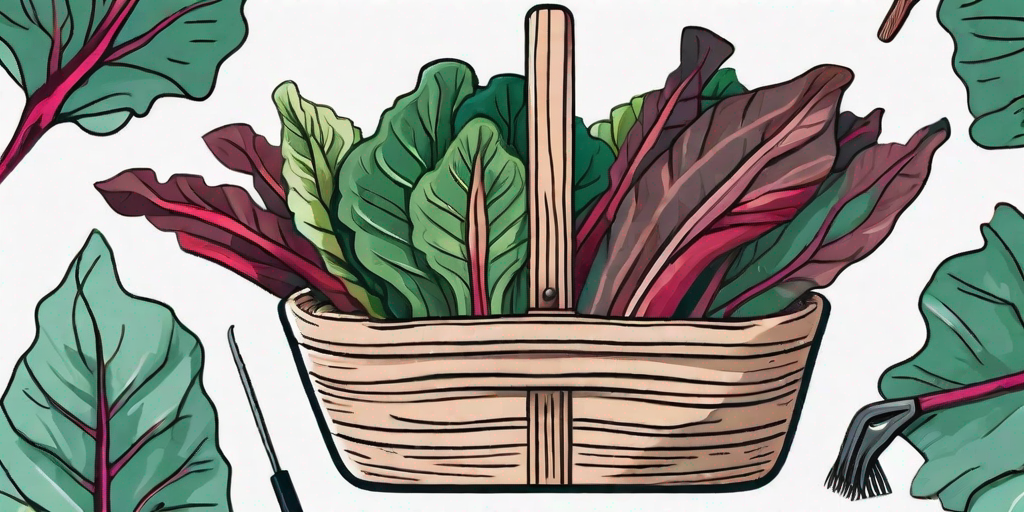
Swiss chard, also known as silverbeet, is a leafy green vegetable that is packed with nutrients and easy to grow. It's a favorite among gardeners for its vibrant colors and hearty growth. But, how do you go from planting a seed to harvesting a bunch of Swiss chard like a pro? Fear not, green-thumbed friends, we've got you covered.
Understanding Swiss Chard
Before we dive into the nitty-gritty of harvesting, let's take a moment to appreciate the Swiss chard. This leafy green is a member of the beet family, but unlike its root vegetable cousins, it's grown for its large, flavorful leaves rather than its root.
Swiss chard is a cool-season crop, which means it prefers the milder temperatures of spring and fall. It can tolerate a bit of frost, but too much heat will make it bolt, or go to seed. Bolting is the plant's way of saying, "I'm done here, thanks for the memories."
The Nutritional Powerhouse
Swiss chard is a nutritional powerhouse, packed with vitamins A, C, and K, as well as magnesium, potassium, and iron. It's like the superhero of the vegetable world, swooping in to save the day with its nutrient-dense leaves.
Plus, it's low in calories and high in fiber, making it a great choice for those looking to maintain a healthy weight. So, not only does it taste good, but it's also good for you. Talk about a win-win!
Planting Swiss Chard
Now that we've sung the praises of Swiss chard, let's get down to business. The first step in harvesting Swiss chard like a pro is, of course, planting it.
Swiss chard is a relatively easy plant to grow, making it a great choice for beginners. It can be grown from seeds or transplants, and it prefers well-drained soil with a pH between 6.0 and 7.0.
From Seed to Seedling
When planting Swiss chard from seed, you'll want to sow the seeds about 1/2 inch deep and 3 inches apart. After the seedlings emerge, thin them to about 6 inches apart. This gives the plants plenty of room to grow and ensures a healthy harvest.
Swiss chard seeds are actually clusters of seeds, so don't be surprised if you see multiple seedlings sprouting from a single seed. It's like a little Swiss chard party!
Transplanting Swiss Chard
If you're starting with transplants, plant them about 6 inches apart in well-drained soil. Be sure to water them thoroughly after planting to help them settle in.
Swiss chard transplants are a great option for those who want to get a jump start on the growing season. Plus, they're a bit more forgiving than seeds, making them a good choice for those who are new to gardening.
Harvesting Swiss Chard
Alright, now for the moment you've all been waiting for: the harvest. Harvesting Swiss chard is a bit like giving a haircut. You want to trim the outer leaves while leaving the inner ones to continue growing.
When the leaves are about 6 to 8 inches long, they're ready to be harvested. Simply cut the leaf at the base of the plant with a sharp knife or scissors. Be sure to leave the inner leaves intact so the plant can continue to produce.
Timing is Everything
Swiss chard can be harvested as soon as the leaves are large enough to eat. However, the leaves are most tender and flavorful when they're harvested young. So, don't be shy about harvesting early and often.
Remember, Swiss chard is a cut-and-come-again plant, which means it will continue to produce leaves throughout the growing season. So, the more you harvest, the more it grows. It's the gift that keeps on giving!
Storing Swiss Chard
After harvesting, Swiss chard can be stored in the refrigerator for up to a week. Simply wrap the leaves in a damp paper towel and place them in a plastic bag. For longer storage, Swiss chard can be blanched and frozen.
Swiss chard is a versatile vegetable that can be used in a variety of dishes. It can be sautéed, steamed, or used raw in salads. So, don't be afraid to get creative in the kitchen!
Common Questions About Swiss Chard
Is Swiss chard easy to grow?
Yes, Swiss chard is a relatively easy plant to grow, making it a great choice for beginners. It can be grown from seeds or transplants, and it prefers well-drained soil with a pH between 6.0 and 7.0.
When should I harvest Swiss chard?
Swiss chard can be harvested as soon as the leaves are large enough to eat. However, the leaves are most tender and flavorful when they're harvested young. So, don't be shy about harvesting early and often.
How do I store Swiss chard?
After harvesting, Swiss chard can be stored in the refrigerator for up to a week. Simply wrap the leaves in a damp paper towel and place them in a plastic bag. For longer storage, Swiss chard can be blanched and frozen.
Conclusion
There you have it, folks. A comprehensive guide to harvesting Swiss chard like a pro. With a bit of knowledge and a dash of humor, you'll be reaping the rewards of your green thumb in no time. So, get out there and get your greens!
Remember, gardening is a journey, not a destination. So, enjoy the process, learn from your mistakes, and don't forget to have fun. Happy gardening!











